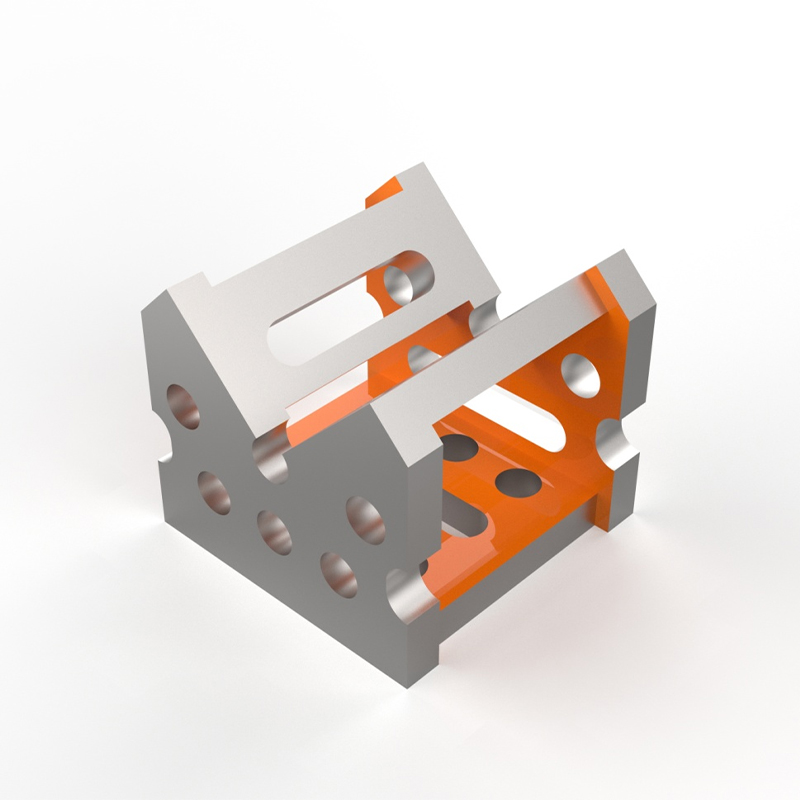द्वि-आयामी वेल्डिंग लचीला कार्यक्षेत्र त्रि-आयामी लचीले संयुक्त टूलिंग और स्थिरता प्रणाली का मूल मंच है। यह दो श्रृंखलाओं में विभाजित है: D28 और D16। D28 सीरीज़ प्लेटफॉर्म का होल रिक्ति 100 मिमी है, और विमान को 100 × 100 ग्रिड लाइनों के साथ उकेरा गया है। D16 सीरीज़ प्लेटफॉर्म का होल रिक्ति 50 मिमी है, विमान को वर्कपीस के दृश्य निरीक्षण को सुविधाजनक बनाने के लिए 50 × 50 ग्रिड लाइनों के साथ उत्कीर्ण किया गया है। ग्राहकों की आवश्यकताओं के अनुसार, मिलीमीटर के तराजू को प्लेटफ़ॉर्म के दो दाहिने-कोण वाले पक्षों पर नक्काशी किया जा सकता है। टेबल टॉप ग्रिड होल के रूप को अपनाता है। प्लेटफ़ॉर्म आकार को वास्तविक आवश्यकताओं के अनुसार भी अनुकूलित किया जा सकता है।
A द्वि-आयामी लचीली वेल्डिंग कार्यक्षेत्र एक अत्यधिक सटीक और अनुकूलनीय कार्य सतह है जो विशेष रूप से वेल्डिंग और निर्माण कार्यों के लिए डिज़ाइन की गई है। छेद या स्लॉट के ग्रिड पैटर्न के साथ एक फ्लैट टॉप की विशेषता, यह दो-आयामी विमान में घटकों के तेजी से, सटीक सेटअप और सुरक्षित क्लैंपिंग के लिए अनुमति देता है। यह प्रणाली, जिसे अक्सर एक के रूप में संदर्भित किया जाता है मॉड्यूलर वेल्डिंग टेबल, जटिल विधानसभाओं के लिए एक स्थिर, विन्यास योग्य नींव प्रदान करके वेल्डिंग सटीकता, पुनरावृत्ति और समग्र कार्यशाला दक्षता को बढ़ाता है।
एक दो-आयामी लचीले वेल्डिंग वर्कबेंच को क्या परिभाषित करता है?
नाम ही इसकी प्रमुख विशेषताओं पर प्रकाश डालता है। "दो-आयामी" फ्लैट काम की सतह (एक्स और वाई कुल्हाड़ियों) को संदर्भित करता है जहां घटकों को एकीकृत ग्रिड सिस्टम का उपयोग करके तैनात और सुरक्षित किया जाता है। "लचीला" इस ग्रिड द्वारा प्रदान की गई अनुकूलनशीलता पर जोर देता है; छेद या स्लॉट में डाले गए विभिन्न क्लैंप, बोल्ट, स्टॉप और कोणों का उपयोग करते हुए, उपयोगकर्ता लगभग किसी भी परियोजना के लिए कस्टम जिग्स और जुड़नार बना सकते हैं। यह अनुकूलनशीलता जटिल काम के लिए पारंपरिक फ्लैट टेबल से कहीं बेहतर है।
एक उच्च गुणवत्ता वाली प्रणाली की मुख्य घटक और विशेषताएं
घटकों को समझना एक के मूल्य की सराहना करने के लिए महत्वपूर्ण है द्वि-आयामी लचीली वेल्डिंग कार्यक्षेत्र.
टेबलटॉप: सटीक की नींव
सिस्टम का दिल टेबलटॉप है। आमतौर पर उच्च शक्ति वाले स्टील (जैसे S355JR स्टील) से तैयार किया जाता है, यह अक्सर प्लाज्मा नाइट्राइडिंग जैसी प्रक्रियाओं से गुजरता है। यह सतह उपचार उत्कृष्ट कठोरता (750 विकर्स तक), जंग प्रतिरोध प्रदान करता है, और वेल्ड स्पैटर आसंजन को काफी कम करता है। परिभाषित करने वाली विशेषता छेदों की सटीक ग्रिड है (आमतौर पर ø16mm या ø28mm) या स्लॉट्स, तंग सहिष्णुता के लिए मशीनीकृत (जैसे, छेद की स्थिति के लिए ± 0.05 मिमी)। समान रूप से महत्वपूर्ण सतह की सपाटता है, जिसे अक्सर पूरी मेज पर एक मिलीमीटर के दसवें हिस्से के भीतर निर्दिष्ट किया जाता है (जैसे, 0.1 मिमी/1000 मिमी की सपाटता सहिष्णुता), सटीक विधानसभा सुनिश्चित करना - यह एक सच है परिशुद्धता वेल्डिंग टेबल.
क्लैम्पिंग और फिक्सिंग सिस्टम: एक्शन में बहुमुखी प्रतिभा
यह कार्यक्षेत्र वास्तव में एक के रूप में चमकता है वेल्डिंग स्थिरता तालिका इसके क्लैंपिंग सिस्टम के लिए धन्यवाद। ग्रिड पैटर्न को विशेष टूलिंग की एक विस्तृत सरणी को स्वीकार करने के लिए डिज़ाइन किया गया है:
- क्लैंप: विभिन्न शैलियों (स्क्रू क्लैंप, टॉगल क्लैम्प्स, मैग्नेटिक क्लैंप) जो वर्कपीस को सुरक्षित करने के लिए छेद/स्लॉट में लंगर डालते हैं।
- बोल्ट: टेबल पर सुरक्षित रूप से क्लैंप और पोजिशनिंग तत्वों को जकड़ने के लिए उपयोग किया जाता है।
- स्टॉप और कोण: प्रिसिजन-मशीनीकृत ब्लॉक और कोण एक दूसरे के सापेक्ष घटकों को सटीक रूप से स्थिति और टेबल ग्रिड के सापेक्ष स्थिति के लिए उपयोग किया जाता है।
- रिसर ब्लॉक: वर्कपीस को ऊंचा करें या बहु-स्तरीय जुड़नार बनाएं।
इस की मॉड्यूलरिटी वेल्डिंग क्लैंपिंग टेबल सिस्टम अनंत विन्यास के लिए अनुमति देता है, प्रत्येक नौकरी के लिए समर्पित जिग्स के निर्माण की तुलना में महत्वपूर्ण समय की बचत करता है।
समर्थन संरचना: स्थिरता और भार क्षमता
एक मजबूत फ्रेम और लेग सिस्टम भारी घटकों का समर्थन करने और एक निर्माण वातावरण की कठोरता का सामना करने के लिए आवश्यक हैं। लेग्स को अक्सर भारी-गेज स्टील टयूबिंग से बनाया जाता है और कार्यशाला के भीतर गतिशीलता के लिए असमान मंजिलों या भारी-शुल्क वाले कैस्टर (लॉकिंग मैकेनिज्म के साथ) पर लेवलिंग के लिए समायोज्य पैरों की सुविधा हो सकती है। लोड क्षमता एक महत्वपूर्ण विनिर्देश है, जो अधिकतम वजन का संकेत देता है कि तालिका सुरक्षित रूप से समर्थन कर सकती है।
2 डी वेल्डिंग टेबल सिस्टम को लागू करने के प्रमुख लाभ
एकीकृत एक द्वि-आयामी लचीली वेल्डिंग कार्यक्षेत्र अपने वर्कफ़्लो में पर्याप्त लाभ प्रदान करता है:
- बेजोड़ सटीक और पुनरावृत्ति: सटीक ग्रिड और फिक्सिंग घटक सुनिश्चित करते हैं कि भागों को हर बार सही ढंग से तैनात किया जाता है, गुणवत्ता नियंत्रण और बैच उत्पादन के लिए महत्वपूर्ण है।
- काफी कम सेटअप समय: कस्टम जिग्स को गढ़ने के बजाय मानक घटकों का उपयोग करके जटिल जुड़नार को जल्दी से इकट्ठा करें। यह उत्पादकता को काफी बढ़ाता है।
- परम बहुमुखी प्रतिभा: आसानी से अलग -अलग परियोजनाओं के लिए सेटअप को छोटे जटिल भागों से लेकर बड़े फ्रेम तक, एक ही बेस टेबल और टूलींग का उपयोग करके अनुकूलित करें। एक लचीले का मूल 2 डी वेल्डिंग टेबल सिस्टम.
- बेहतर वेल्ड गुणवत्ता: स्थिर और सटीक स्थिति विकृति को कम करती है और उचित संयुक्त फिट-अप सुनिश्चित करती है।
- बढ़ी हुई कार्यशाला सुरक्षा: वर्कपीस को सुरक्षित रूप से पकड़ना वेल्डिंग या पीसने के दौरान आंदोलन को रोकता है, दुर्घटनाओं के जोखिम को कम करता है।
द्वि-आयामी वेल्डिंग लचीला कार्यक्षेत्र आयाम:
1000 × 1000 2000 × 1000 2400 × 1200 1200 × 1200 1500 × 1500 3000 × 1500
छेद का आकार:
φ28 श्रृंखला प्लेटफ़ॉर्म: छेद सहिष्णुता D10 स्तर है, और प्लेटफ़ॉर्म से मेल खाने वाला लॉकिंग पिन H7 स्तर है। दो आसन्न छेदों के बीच की दूरी 100 ± 0.05 मिमी है
φ16 सीरीज़ प्लेटफॉर्म: होल टॉलरेंस D10 स्तर है, और प्लेटफ़ॉर्म से मेल खाने वाला लॉकिंग पिन H7 स्तर है। दो आसन्न छेदों के बीच की दूरी 50 ± 0.05 मिमी है।
वर्कबेंच कॉलम के तीन प्रकार हैं: ऊँचाई (तीन प्रकार) के साथ 2T की लोड-असर क्षमता के साथ, फिक्स्ड (फ्रेम प्रकार) 5T की लोड-असर क्षमता के साथ, मूव्ड (3T की लोड-असर क्षमता के साथ लिफ्टिंग प्रकार), (1T की लोड-असर क्षमता के साथ ब्रेक के साथ स्पिंडल प्रकार)।
उद्योगों के सामान्य अनुप्रयोग
इन कार्यक्षेत्रों की सटीकता और लचीलापन उन्हें विभिन्न क्षेत्रों में अमूल्य बनाता है:
- सामान्य धातु निर्माण: बिल्डिंग फ्रेम, चेसिस, गेट्स, रेलिंग और कस्टम धातु संरचनाएं।
- मोटर वाहन: चेसिस सेटअप, निकास निर्माण, कस्टम पार्ट संरेखण।
- एयरोस्पेस: तंग सहिष्णुता की आवश्यकता वाले घटकों की सटीक विधानसभा।
- रोबोटिक वेल्डिंग: स्वचालित वेल्डिंग प्रक्रियाओं के लिए एक सुसंगत और सटीक आधार प्रदान करना।
- प्रोटोटाइप और आर एंड डी: अलग -अलग विधानसभा कॉन्फ़िगरेशन का परीक्षण जल्दी से।
- व्यावसायिक प्रशिक्षण: मौलिक और उन्नत वेल्डिंग और फिक्सिंग तकनीक सिखाना।
सही द्वि-आयामी लचीला वेल्डिंग वर्कबेंच चुनना
उपयुक्त तालिका का चयन करना आपकी विशिष्ट आवश्यकताओं पर निर्भर करता है। इन कारकों पर विचार करें:
| कारक | विचार | उदाहरण विकल्प / चश्मा |
| तालिका आकार | मैच कार्यक्षेत्र और विशिष्ट परियोजना आयाम। | 1000x1000 मिमी, 1200x800 मिमी, 1500x1000 मिमी, 2000x1000 मिमी, 2400x1200 मिमी, आदि। |
| ग्रिड तंत्र | छेद व्यास (टूलिंग के साथ संगतता) और रिक्ति (फिक्सिंग घनत्व)। | 50 मिमी ग्रिड पर Ø16 मिमी छेद, 100 मिमी ग्रिड पर ve28 मिमी छेद। कुछ टेबल्स में स्लॉट होते हैं। |
| सामग्री और खत्म | स्थायित्व, स्पैटर प्रतिरोध, कठोरता। | उच्च शक्ति स्टील (जैसे, S355JR), प्लाज्मा नाइट्रेड सतह। |
| भार क्षमता | सुनिश्चित करें कि यह आपके विशिष्ट वर्कपीस और फिक्स्चर के वजन को संभाल सकता है। | आकार और निर्माण के आधार पर 500kg, 1000kg, 2000kg+। |
| सटीकता चश्मा | टेबल सपाटता, छेद की स्थिति सहिष्णुता। सटीक काम के लिए महत्वपूर्ण। | सपाटता: <0.1 मिमी/एम, छेद सहिष्णुता: ± 0.05 मिमी। |
| गौण पारिस्थितिकी तंत्र | उपलब्धता और संगत क्लैंप, स्टॉप, कोणों की सीमा। | निर्माता के कैटलॉग की जाँच करें (AWS जैसे उद्योग संसाधन संदर्भ प्रदान कर सकते हैं)। |
दीर्घायु और सटीकता के लिए रखरखाव युक्तियाँ
अपने को रखने के लिए द्वि-आयामी लचीली वेल्डिंग कार्यक्षेत्र इष्टतम स्थिति में:
- वेल्ड स्पैटर को नियमित रूप से साफ करें। नाइट्राइड सतहों को यह आसान बनाती है, लेकिन त्वरित सफाई सबसे अच्छी है।
- सतह की रक्षा के लिए भारी वेल्डिंग सत्रों से पहले एंटी-स्पैटर स्प्रे लागू करें।
- चरम सटीकता की आवश्यकता होने पर समय -समय पर सटीक सीधे किनारे का उपयोग करके टेबल फ्लैटनेस की जांच करें।
- क्षति को रोकने के लिए क्लैम्पिंग घटकों को साफ और व्यवस्थित रखें और त्वरित पहुंच सुनिश्चित करें।
- सतह को भारी प्रभावों या गॉज से सुरक्षित रखें।
अंत में, द्वि-आयामी लचीली वेल्डिंग कार्यक्षेत्र सिर्फ एक तालिका से अधिक है; यह एक परिष्कृत प्रणाली है जो सटीक, लचीलापन और दक्षता के लिए इंजीनियर है। एक गुणवत्ता प्रणाली में निवेश करके और अपनी क्षमताओं का प्रभावी ढंग से उपयोग करके, फैब्रिकेटर अपने काम की गुणवत्ता में काफी सुधार कर सकते हैं, उत्पादन समय को कम कर सकते हैं, और समग्र कार्यशाला उत्पादकता को बढ़ा सकते हैं।





















